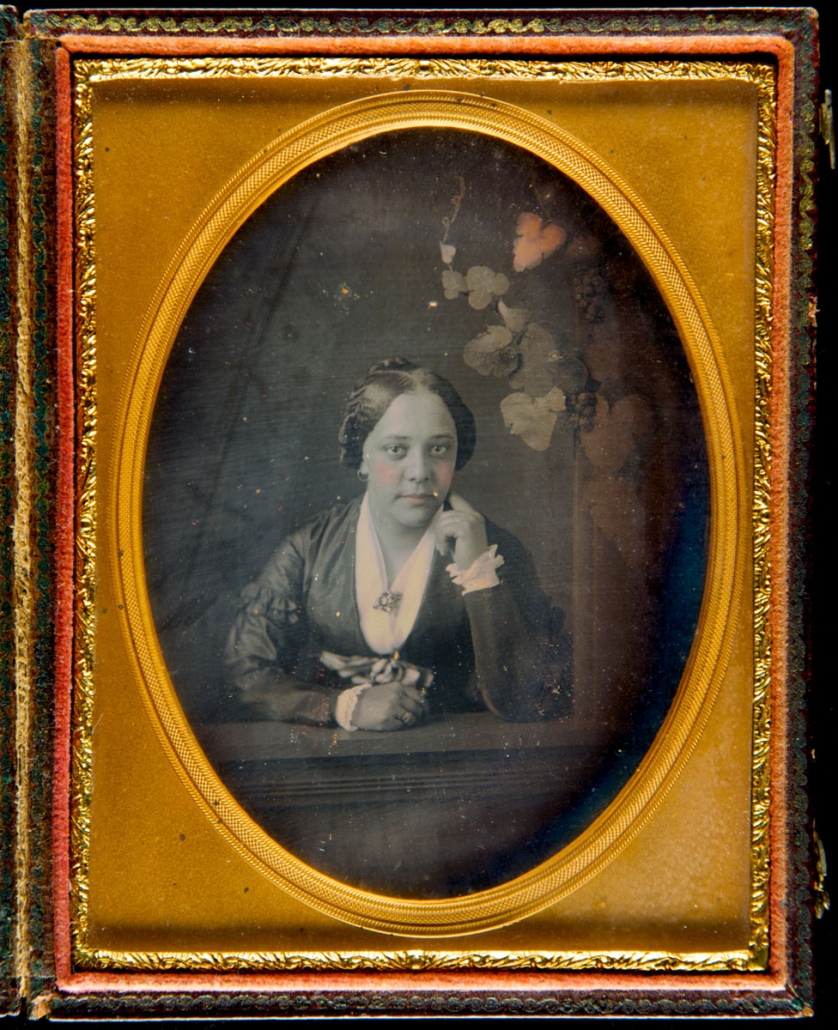[African American Woman Seated in Window Frame].
Clayton Lewis, Curator of Graphic Materials, William L. Clements Library, University of Michigan

Examined only digital image.
Title: [African American woman seated in window frame].
Format: Visual Material
Main Author: [Broadbent, S. (Samuel), 1810-1881]
Published/created: Philadelphia : Samuel S. Broadbent, circa. 1850s
Language: Not applicable
Copy-Specific Note: Leather case with gold edge, oval brass mat.
Copy-Specific Note: [Acquisition info]
Note: Bust length studio portrait of African American woman in a dark dress with tight braided hair, earrings, brooch and ring, seated in window frame with decorative arrangement of ivy
Physical Description: 1 photograph : daguerreotype; plate 105 x 80 mm. (quarter plate format), hand-tinted.
Subjects:
African Americans — portraits — 1850-1860.
Women — 1850-1860.
Daguerreotypes — 1850-1860.
Portrait photographs — 1850-1860.
This is a quarter-plate daguerreotype portrait that appears to be in a standard leather case with an oval brass mat, all of which is typical of American daguerreotypes of the 1850s. The subject is a well-dressed African American woman with tightly braided hair; wearing a simple dark dress with sleeve ruffles on the upper arm; a light-colored V-neck blouse without collar, and jewelry that includes earrings, a brooch, and rings. She is sitting with one arm resting on a window frame, the other arm held below her chin, with one finger resting against her neck. Her expression is one of dignity, composure and perhaps slight fatigue. The composition is framed by a false window with decorative vines along one side.
This daguerreotype by Samuel Broadbent is a terrific example of how the commonplace genre of portrait photography could become a radical statement of inclusion and determination. At the time of violent racist oppression and enslavement in America, an African American woman sat in the gallery of one of Philadelphia’s top portrait photographers. She brought dignity and self-assurance, and comfortably showed possessions indicating material wealth and social status. All of these components can of course be found in the millions of daguerreotype portraits of Caucasian Americans taken in the 19th-century. The enormous volume and ubiquity of these images reduces the content to near meaninglessness. For an African American to assert that same place of normalcy in middle-class American society — a place presumed to be occupied by whites — challenged the established norms of the day.
When Samuel Broadbent removed the lens cap from his camera to photographically etch this image on a metal plate, American visual culture was flooded with racist, derogatory, caricatures of African Americans. Frederick Douglass wrote and spoke eloquently about the power of visual culture and his distrust of the ability of white artists to depict Black people. Yet Douglass consented to have his photographic likeness taken again and again, to the extent that he may have literally been the most photographed 19th-century American notable. The overwhelming presence of racist visuals in print culture made clear to many African Americans that the new photographic media —a form that was widely perceived as more truthful and objective — had power when truth was linked to freedom and fiction was justification of enslavement. Photography could be steered towards statements of status, place, and belonging that were backed by the inherent truth of the medium.
Additionally, portrait photograph subjects quickly found that through controlling the expressive details of the pose, they could become active partners in the creation of their own image, in a manner different from the subjugation that often occurred in the hands of a portrait painter. Skilled craftsmen often brought tools of the trade to photo sessions to proudly assert their identity with a career. Details such as jewelry, books and fine clothes signaled rank and status to the viewer. In this way, the subject was a creative partner with some control of the final product.
Who chose the decorative vines that embellish, frame, and soften the context for the sitter in this portrait? Although it was in fact an often-used studio prop of Broadbent’s, the woman who sat within this window frame vignette did so by choice. She is telling us that she too is worthy of the same sentiment and human emotion often denied her race. Yes, this portrait has many generic elements, however this ordinariness is interrupted by the unexpected Blackness of the subject. What was generic and passive for a Caucasian portrait became novel and assertive for that of a Black person, including the gentle blush applied to her cheeks and enhancing her lips — entirely consistent with the flattery applied to images of white counterparts.
The subject of this daguerreotype is unknown to us, nonetheless the image speaks to us with confidence about identity. Through this powerful visual medium she declares “I am somebody. I know who I am. I have a place in this society and I have earned it.”
Keywords:
Clothing and dress
Images of empowerment
Studio photography props and fixtures
